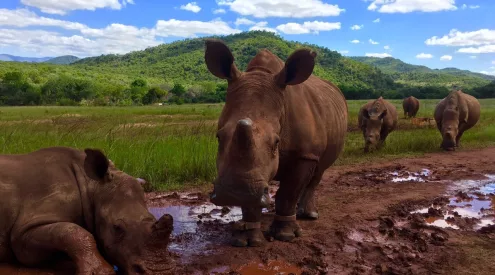Gestation specifically refers to the development period inside the womb from conception to birth. In humans, the 9 month period is long enough to make sure a baby can survive outside the body, but only just. Human infants have a lot more development needed before they can live on their own.
By contrast, animals in the wild don’t have the luxury of caring for a child as intensely, so their babies need to be born more ready to take on the world than we are. In the case of some species, they just need a little longer to grow strong enough.
Here are some of the longest gestation periods in the animal kingdom.
Zebra
The mountain zebra breed from December and February and have a gestation period of 12 months. Their babies are born weighing around 25 kg and learn to walk almost immediately after birth to help avoid predators.
Elephant
View this post on Instagram
This one you might already know as anyone who has been on a safari is likely to hear the fun fact that elephants are pregnant for around 21 months. This contributes to how few babies female elephants have on average and how protective a herd is of its young.
Giraffe
View this post on Instagram
Giraffe have a gestation period of around 15 months and their babies are pretty big when they’re born. They can weigh up to 68 kg at birth. This weight and size are not surprising since the mothers give birth standing up and the babies need to be able to survive the fall.
Camel
Camels have an equally long gestation period, lasting between 13 to 15.
Walrus
View this post on Instagram
Walrus have a gestation period of 15 to 16 months. This is the longest of the pinnipeds, a mammal group which includes seals. Some of this time is taken up by what is called delayed implantation. The fertilised egg doesn’t immediately implant, but rather remains free-floating for up to five months to make sure the mother has recovered from her last pregnancy well enough.
View this post on Instagram
Black salamanders give birth to live young after two or three years of pregnancy. The length of their pregnancy depends on the altitude they live at. Since this is such a long period, it is expected that salamanders only have two fully developed and birthed babies in their lifetime.
Rhino
View this post on Instagram
Rhino pregnancies last between 15 to 18 months depending on the species. This has been a key challenge in the fight against rhino poaching as repopulating takes time and poachers work fast.
Tapirs
View this post on Instagram
The gestation period of these strange looking creatures is 13 months. The offspring are born with special markings and colouring to hide them from predators while they are still young. Once they can walk better and are a bit bigger, their colour darkens into those similar to an adult.
Orca
View this post on Instagram
Orcas or killer whales carry their babies for 17 months before giving birth. This lengthy development and care for their young after they’re born is not a surprise seeing how sophisticated whale societies are.
Image credit: @fyhagal/Instagram


















